South Dakota Department of Game, Fish, and Parks
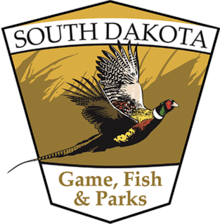 Official Logo of the South Dakota GFP | |
| Agency overview | |
|---|---|
| Formed | 1918 |
| Type | Fish and Wildlife Management, Parks and Recreation, Law Enforcement Agency |
| Jurisdiction | State of South Dakota |
| Headquarters |
523 E Capitol Ave, Pierre, South Dakota 57501 44°21′56″N 100°20′44″W / 44.365453°N 100.345622°WCoordinates: 44°21′56″N 100°20′44″W / 44.365453°N 100.345622°W |
| Annual budget | $56,246,035 (FY 2018) |
| Agency executives |
|
| Child agencies |
|
| Website |
gfp |
| Map | |
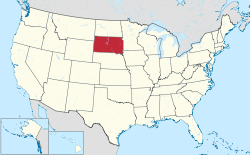 Jurisdiction of South Dakota GFP | |
The South Dakota Department of Game, Fish, and Parks (GFP) is the Government agency of the U.S. state of South Dakota charged with stewardship of the state's fish, wildlife, state park, and outdoor recreation resources. The department is also charged with issuing of state hunting licenses, fishing licenses, and boat registrations. It conducts public education programs for hunting and boating safety. The agency is headquartered in Pierre, South Dakota[1].
Game, Fish, and Parks Commission
The South Dakota Department of Game, Fish and Parks (GFP) manages the outdoor resources and associated recreational activities of the state under the authority granted by the South Dakota Constitution through South Dakota Codified Laws, Administrative Rules of South Dakota and policies of the Department. The GFP Commission serves as the advocate and liaison between the South Dakota Game, Fish and Parks and its customers and partners. The Commission consists of eight members, appointed by the Governor of South Dakota for four year terms.
Making changes in how the Department manages or regulates these resources requires different procedures and actions depending on whether the desired change is governed by state law, administrative rule or Department practices. For example, while state law requires hunters to have a license to hunt deer, the GFP Commission sets a limit on the number of deer licenses that can be issued and then the Department establishes a deadline for hunters to submit applications for licenses. Changes in Administrative Rules require approval by the GFP Commission. Changes in the way the Department conducts or implements a business practice is approved at the Department level. Changes in state law require legislation. GFP is available to help customers if they are seeking a change with an administrative rule.
The Public Hearing portion of the Commission meetings is specifically designated for those attending the meeting to share their comments, thoughts, concerns and ideas on the specific rule changes of items listed within the finalizations section of the agenda. The Public Hearing is required by law and occurs before final action can be taken on the rule changes the Commission has before them for final consideration.
The commission sets rules, regulation, and policy for agency direction.[2]
Divisions
Wildlife Division
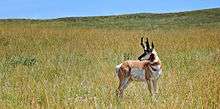
.jpg)
The Wildlife Division manages state wildlife areas, game production areas, and helps manage the various animal, fish, and plant species of South Dakota. The wildlife division helps monitor wildlife populations, establish hunting seasons, and manages state-owned lands for habitat for these species.
Game species managed by the GFP in South Dakota include: Antelope, Bighorn sheep, White-tailed deer, Mule deer, Elk, Mountain goat, Mountain lion, Bison, Turkey, Common pheasant, Prairie grouse, Sage grouse, Ruffed grouse, Partridge, Mourning dove, Cottontail rabbit, Common snipe, American crow, Quail, Tree squirrel, and vaioius waterfowl including Duck, Canada goose, and Snow goose. The taking or hunting of these species requires a State-issued Hunting license and may only be hunted during designated Hunting seasons. The GFP also regulates the Trapping of furbearing animals such as coyote, raccoon, beaver, muskrat, bobcats, mink and red fox within the state[3].
Law Enforcement
The Law Enforcement Division consists of Conservation Officers who are commissioned law enforcement officers, that enforce laws and conduct investigations related to hunting, fishing, boating, and other outdoor recreation activities. As fully commissioned law enforcement officers they do have the same authority as any other police officer to enforce state and local laws throughout the state of South Dakota. Officers primarily patrol public lands and waters within the state. Officers are trained as first responders and respond to such incidents such as boating and ATV accidents. As of 2018 there are 60 Conservation Officers stationed throughout the state. There are 10 Law Enforcement Patrol Districts located in the cities of: Aberdeen, Chamberlain, Ft. Pierre, Ipswich, Milbank, Miller, Rapid City, Sioux Falls, Spearfish, and Yankton.[4].
Parks and Recreation
GFP operates 13 state parks, 43 recreation areas, four nature areas, two historic sites and one trail, totaling approximately 96,000 acres. These areas preserve natural geologic features, historic and sacred Plains Indian sites, and historic pioneer settlements and forts. They also provide recreational facilities and access to waterbodies, including the Missouri River, on which there are 25 recreation areas.
South Dakota State Parks and recreation areas range in size from the 19-acre Sandy Shore Recreation Area to the 71,000-acre Custer State Park. It was the first park established in the system, in 1919. Good Earth State Park at Blood Run is the most recent park, added in 2013. System-wide visitation in 2016 was 7,500,000.
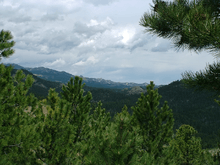 View of the Black Hills within Custer State Park
View of the Black Hills within Custer State Park Sylvan Lake in Custer State Park
Sylvan Lake in Custer State Park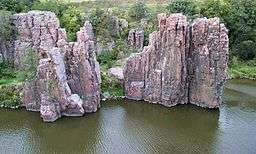 King and Queen Rock in Palisades State Park
King and Queen Rock in Palisades State Park Bear Butte State Park, near Sturgis
Bear Butte State Park, near Sturgis Officers' Quarters at Fort Sisseton State Historical Park.
Officers' Quarters at Fort Sisseton State Historical Park.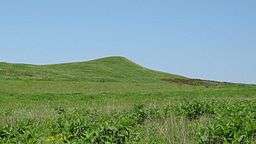
Education and outreach
The GFP offers a variety of educational resources including curriculum supplements, outdoor skills and safety training, education materials (field guides, learning kits), and a variety of other resources (DNR for kids, grants).
GFP operates two Outdoor Campus facilities, located in Sioux Falls, South Dakota and Rapid City, South Dakota for public outreach and outdoor education for the state's two largest cities.
Fisheries
The fisheries division operates state fish hatcheries, conducts fish health, population and other studies, and stocks rivers, lakes and streams[5].
The GFP currently owns and manages four state Fish hatchery facilities, they are:
- Blue Dog State Fish Hatchery in Waubay
- Cleghorn Springs State Fish Hatchery in Rapid City
- McNenny State Fish Hatchery in Spearfish
- Whitlock Bay Salmon Spawning Station in Gettysburg